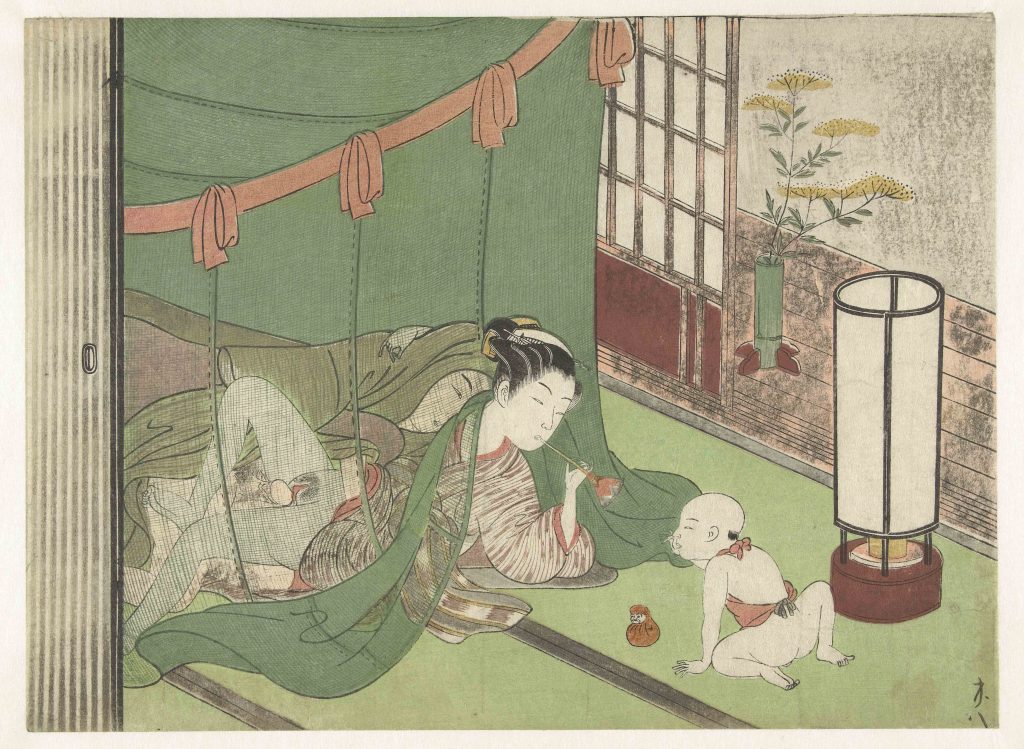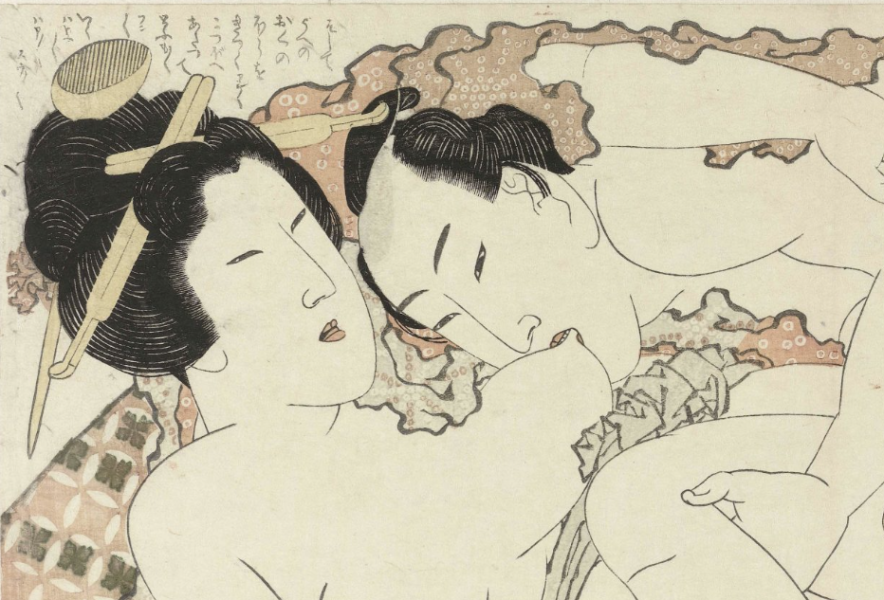Shunga is a representative sexual art of the Edo period. Shunga is currently attracting a lot of attention in Japan, with a series of films on the subject being released this autumn.
Shunga has been around since the Heian period⁈
Shunga refers to paintings depicting the secret sexual activities of men and women. The content is mainly bedchamber drawings of men and women, but also depicts scenes of homosexuality and masturbation, sometimes in a very naked manner, and sometimes with a touch of humour.
Shunga originated in ancient times, and the oldest known Japanese shunga is believed to be the Koshibagaki-zoshi(小柴垣草紙), painted in the late Heian period (794-1185). It is also known that behind the ceiling of the five-storey pagoda of the World Heritage Site Houryuu-ji Temple there are Shunga paintings thought to have been drawn by carpenters, and it is said that they were charms to ward off fire. In the Warring States period, samurai warriors are said to have carried Shunga inside their armour as a charm to ward off evil.

Japanese men and women trying to make love. Man in a loincloth, woman in a kimono, Sugimura Jihei, 1690 (image from Rijksmuseum)
See also Why Ukiyo-e is said it was a “Media”? How did people in Edo enjoy them?
The development of woodblock printing techniques spread to the public
Shunga was painted by ukiyo-e artists and reached its heyday with the development of woodblock printing techniques. Most of the famous ukiyo-e artists, including Kitagawa Utamaro(喜多川歌麿), Katsushika Hokusai(葛飾北斎) and Utagawa Kunisada(歌川国貞), produced shunga, with Utamaro’s ‘Utamakura’ and Hokusai’s ‘Nami-chidori’ considered to be masterpieces.
Shunga, like ukiyo-e in general, can be divided into two main types: nikuhitsu-ga (hand paintings) and woodblock prints. Ninkuhitsu-ga are one-off picture scrolls hand-painted by the artist on paper or silk, while woodblock prints are usually printed on woodblocks, and are usually a set of 12 themed Shunga.
Only the privileged few were able to produce hand paintings, which were produced in lavish private editions, and the development of woodblock printing technology in the second half of the 17th century made it possible to mass produce and publish shunga at a reasonable price. They became widely available to the general public, and the ‘koshoku hon(好色本)’, a collection of shunga, became very popular.

Geisha in long underwear and her lover ,Utamaro Kitagawa, 1799, Japan (image from Rijksmuseum)
The ‘Kyoho Reforms’ of the 8th shogun, Tokugawa Yoshimune, led to the Shogunate cracking down on shochibon, but this did not diminish their popularity. The fact that they were sold privately led to the creation of highly artistic works, such as those with extreme colours that could not normally be published.
Ukiyo-e artists such as Hokusai escaped the Shogunate’s crackdown by inscribing ‘Ingou(隠号)’ in their paintings. Representative examples include Katsushika Hokusai’s Tetsubou Nurunara(鉄棒ぬらぬら), Murasakiiro Ganko(紫色雁高), Utagawa Kunisada’s Bukiyo Matabei(不器用又平), Yanagawa Shigenobu’s Tsuyagawa Yoshinobu(艶川好信) and Utagawa Hiroshige’s Iroshige(色重, which not only showed great skill in painting but also a sense of humour in the hidden sign.

A man and a woman make love under a mosquito net, while the woman fawns over her child with a toy, Katsushika Hokusai, Japan (image from Rijksmuseum)
See also Who is Katsushika Hokusai? What is so great about ‘Great Wave’?
Influenced Western painters
Shunga is said to have influenced Western painters. Like ukiyo-e, shunga is said to have influenced artists such as Picasso during the Japanese cultural fad known as “Japonisme”, which took hold in European countries from the late 19th to the early 20th century.
While Britain initially strictly banned its export as obscene, France recognised its artistic value. Edouard Manet is said to have been so shocked by the debauched and erotic nature of spring painting that he created his famous painting ‘Lunch on the Grass’.
Picasso, one of the most famous painters of the 20th century, was also one of the collectors of spring paintings. A number of drawings are said to have been based on spring paintings.

Man biting a breast, Katsushika Hokusai, Japan (image from Rijksmuseum)
Artistic values to be respected
This autumn, a series of films on the subject of Shunga have been released: the film ‘Shunga Sensei’, released on 13 October, is the first film certified as R15+ for a feature film, and for the first time in Japanese film history, ukiyo-e Shunga is shown on the screen uncensored. Furthermore, the documentary film ‘SHUNGA ‘(R18+) has been on national roadshow since November.
Shunga is remarkable in many ways for its diversity and uniqueness and represents an interesting aspect of traditional Japanese culture as a fusion of sex and art. Despite the strict regulations regarding sexual expression in contemporary Japanese society, its artistic value continues to be respected.
See also Why Ukiyo-e is said it was a “Media”? How did people in Edo enjoy them?

